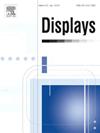Study on interface fatigue failure of flexible OLED display modules based on cyclic cohesive zone model
IF 3.7
2区 工程技术
Q1 COMPUTER SCIENCE, HARDWARE & ARCHITECTURE
引用次数: 0
Abstract
Organic light-emitting diode (OLED) display devices are widely used in the field of electronic display because of their excellent performance, but flexible OLED displays are prone to device damage and peeling failure after multiple bendings. The cohesive zone model (CZM) has great advantages in dealing with interface peeling. In this paper, a cyclic cohesive constitutive model was developed to characterize the peeling phenomenon between the interface of optical clear adhesive (OCA) and cover window under constant cyclic loading in flexible display modules. The model was implemented in ABAQUS by user subroutine to redefine field variables at a material point (USDFLD). Through the bending fatigue peeling experiment and finite element simulation between the cover window and OCA, the cyclic cohesive constitutive parameters were obtained by the parameter inversion method, and the amplification method of fatigue damage variables was optimized. Finally, a flexible OLED simulation model with a multilayer stack structure was established. Compared with the experimental results, the simulation model successfully predicted the peeling failure position, and the relative error between the predicted life value and the experimental value was 16.6%. The applicability of the cyclic cohesive zone model in characterizing the fatigue peeling properties of the interface between the cover window and OCA was validated.
求助全文
约1分钟内获得全文
求助全文
来源期刊

Displays
工程技术-工程:电子与电气
CiteScore
4.60
自引率
25.60%
发文量
138
审稿时长
92 days
期刊介绍:
Displays is the international journal covering the research and development of display technology, its effective presentation and perception of information, and applications and systems including display-human interface.
Technical papers on practical developments in Displays technology provide an effective channel to promote greater understanding and cross-fertilization across the diverse disciplines of the Displays community. Original research papers solving ergonomics issues at the display-human interface advance effective presentation of information. Tutorial papers covering fundamentals intended for display technologies and human factor engineers new to the field will also occasionally featured.
 求助内容:
求助内容: 应助结果提醒方式:
应助结果提醒方式:


